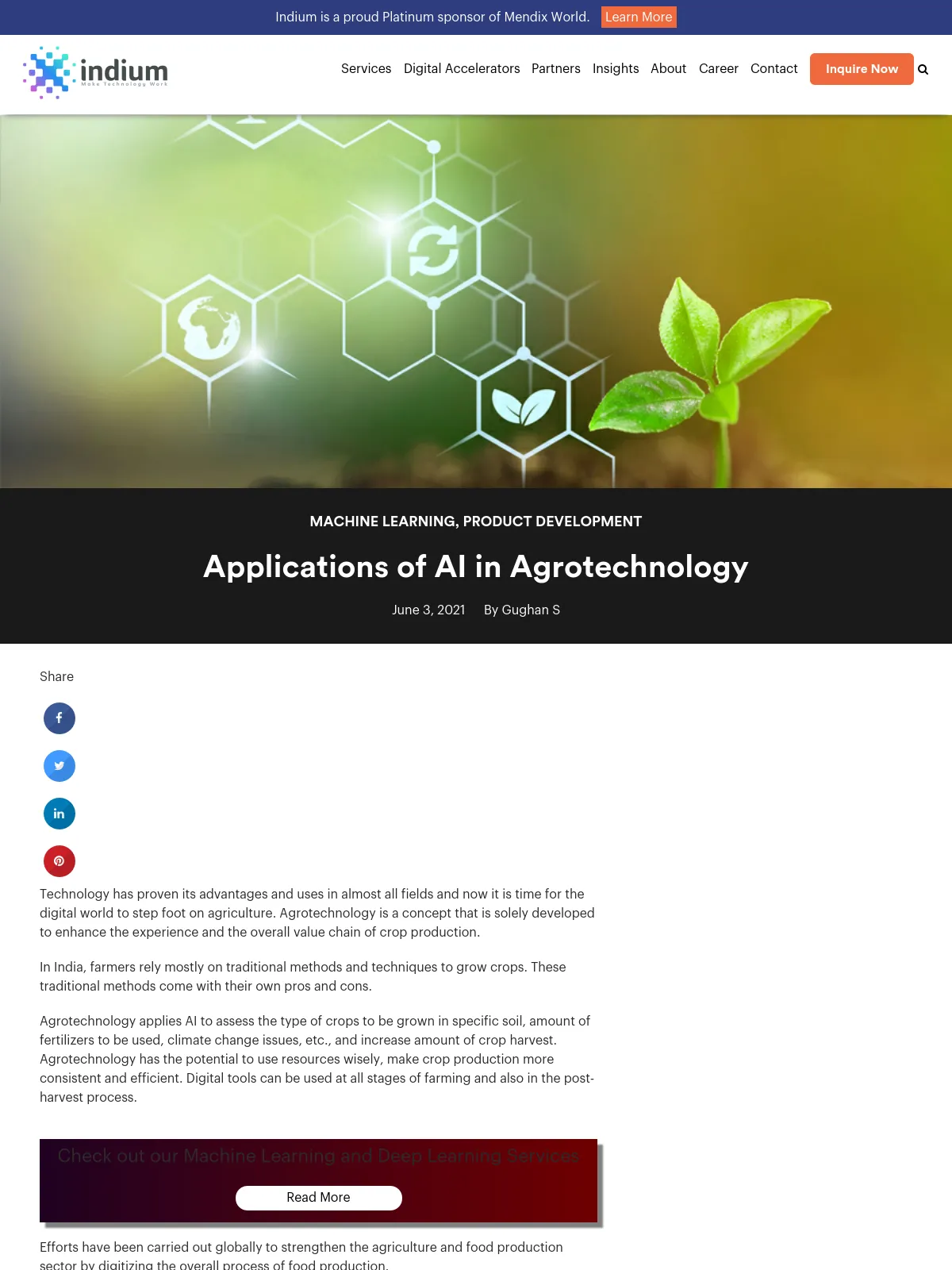Applications of AI in Agrotechnology
Blog: Indium Software - Big Data
Technology has proven its advantages and uses in almost all fields and now it is time for the digital world to step foot on agriculture. Agrotechnology is a concept that is solely developed to enhance the experience and the overall value chain of crop production.
In India, farmers rely mostly on traditional methods and techniques to grow crops. These traditional methods come with their own pros and cons.
Agrotechnology applies AI to assess the type of crops to be grown in specific soil, amount of fertilizers to be used, climate change issues, etc., and increase amount of crop harvest. Agrotechnology has the potential to use resources wisely, make crop production more consistent and efficient. Digital tools can be used at all stages of farming and also in the post-harvest process.
Check out our Machine Learning and Deep Learning Services
Read More
Efforts have been carried out globally to strengthen the agriculture and food production sector by digitizing the overall process of food production.
The Confederation of Indian Industry has suggested several strategies to adopt digital tools for farming and food production,
- Build a digital infrastructure and use satellite imaging and data sources
- Elevate data efficiency by using digitization tools
Technologies For Digitization
In the agricultural sector, many technologies are adopted to digitize the whole process.
Precision agriculture is one such technology that has great potential in changing the way of traditional farming practices. Some of the outcomes of using precision agriculture are,
- Automatic section control
- Yield monitoring
- Chlorophyll sensors
- Soil sampling
- Aerial imagery
- GPS guidance systems
AI sowing application is another initiative that is powered by the Microsoft Cortana
intelligence suite. This app is of great use to farmers, which doesn’t require any investment or installation of sensors. Advisors on sowing seeds are sent as a text message to the registered mobile.
With a further step forward, Microsoft has now developed a Pest Risk Prediction API in
collaboration with United Phosphorus Limited. This uses artificial intelligence to indicate the risk of pest control in advance. This will be of great help in increasing yield and lowering the economic losses caused due to the infestation of pests.
Cloud computing is another technology that helps with real time computation, data access and storage. The pros of using cloud computing for the digitization process include crop related decision making influenced by soil information, monitoring the growth and crops and comparing growth patterns, data of farming practices of local farmers can be studied, etc.
The next technology is the Internet of things (IoT), which translates to a simple definition as the Internet controlling things. Innovation includes agrobots, but these are still under the trial phase or R&D mode. AI aided machines include weeding robots, harvesting robots, material handling, machine navigation.
Technology Related Testing:
Since there are many technologies that are adopted in agriculture, there are a lot of testing processes that are needed to be done before digitalizing the whole process. Among the man testing techniques that are being used in digitalizing agriculture, the one testing technique that plays a major part is the RPA (i.e., Robotic Process Automation) since AI plays importance in many places such as AI sowing application, Automatic section control, weeding robots, harvesting robots, etc
Robotic Process Automation has many different tools which can be used for various types of testing. Each and every tool in RPA has its own and different advantages and disadvantages. Here are few tools and their uses.
| Parameters | Blue Prism | UIPath | Automation Anywhere |
| Architect | Client Server | Orchestrator | Client Server |
| Accuracy | Set for BPO optimization | Set for Web Automation | Rational |
| Cognitive Capability | High | High | Very High |
| Scalability | High-speed execution | Medium speed execution | Limited |
| Re-Usability | Yes | Yes | Yes |
| Recorders | No | Yes | Yes |
| Access | App-based | Mobile Browsing | App-based |
| Reliability | Very high | Moderate | High |
Also, since drones are used in many places to prevent crop yield loss from factors such as
diseases, insects, weeds and nutrient deficiencies, Lithographic lens testing is one of the best testing techniques which can be used to test the measured aerial images, interferometric data, and photoresist measurements.
Leverge your Biggest Asset Data
Inquire Now
Leverge your Biggest Asset Data
Since we have been using technologies like drones, lithographic lens, etc., there are different types of hardware testing too that can be performed over them. A few hardware testing that can be done to check the chassis, motors, Propellers, indicator lights, Global Positioning System, Landing frame, batteries, Electronic Speed Controller, Compass, wiring and Camera.
Conclusion
Finally, these technologies are still under the trial phase so, we have to wait to experience their uses. But once these are implemented successfully, they will be more helpful and useful in the field of agriculture and also it reduces the loss in terms of preventing diseases, weeds and nutrient deficiencies, etc.
Again, every technology has its own advantages and disadvantages so, we can see them in these technologies too.
The post Applications of AI in Agrotechnology appeared first on Indium Software.
